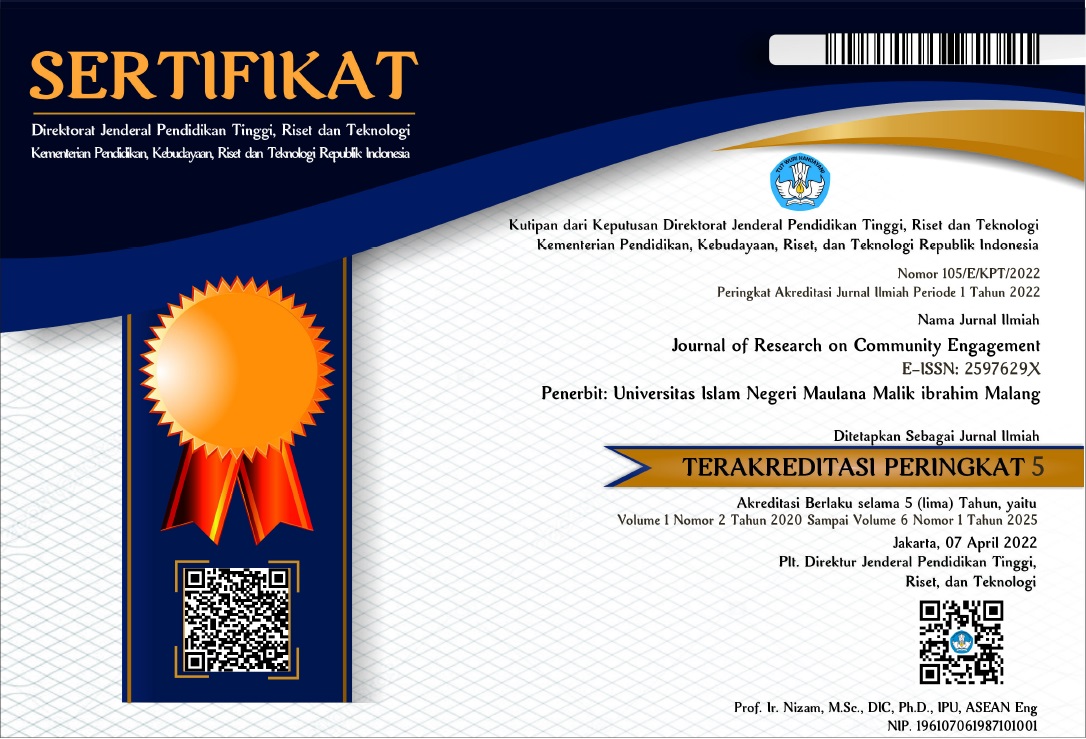UPAYA PENINGKATAN EKONOMI DAN PENGURANGAN SAMPAH DOMESTIK MASYARAKAT SUMBERSARI MELALUI PEMANFAATAN ALIRAN SUNGAI UNTUK BUDIDAYA IKAN MUJAIR
Abstract
Full Text:
PDFReferences
Abdulkadir. 2010. Keramba Jaring Apung. https://www.farraQafay.com. Diakses tanggal 21 November 2019.
Anonim. 2004. Biomanipulasi, paradigma baru dalam pengendalian limbah organik budidaya perikanan di waduk dan tambak
Anonim. 2008a. Pedoman pengelolaan ekosistem danau. Kementerian Lingkungan Hidup. Jakarta, 118 hlm.
Anonim. 2008b. Kegiatan kajian perhitungan daya tampung sungai 3 DAS dan 4 waduk prioritas. Badan Pengelolaan Lingkungan Hidup Daerah Provinsi Jawa Barat. Bandung, 127 hlm.
Anonim. 2009. Undang-Undang Republik Indonesia Nomor 32 tentang Perlindungan dan Pengelolaan Lingkungan Hidup. 110 hlm.
Djamarah, S.B. 2000. Guru dan Anak Didik dalam Interaksi Edukatif. Rineka Cipta. Jakarta.
Effendi, H. 2003. Telaah Kualitas Air Bagi Pengelolaan Sumberdaya dan Lingkungan Perairan. Kanisius. Yogyakarta.
Garno, Y.S. 2002. Beban pencemaran limbah perikanan budidaya dan eutrofikasi di perairan waduk pada DAS Citarum. J. Tek. Ling. P3TL-BBPT 3: 112-120.
Golmand, C.R., dan A.J. Horne. 1989. Limnology. McGraw Hill Company. New York.
Gowen, R.J. 1990. An assessment of the impact of fish farming on the water column and sediment ecosystems of Irish coastal waters. Report prepared for Departement of the marine, Ireland. Departement of the Marine, Dublin.
Imanto, P.T., N. Lisyanto & B. Priono. 1995. Desain dan konstruksi keramba jaring apung untuk budidaya ikan laut. Dalam Sudradjat et al. (Eds.). 1995. Prosiding temu usaha pemasyarakatan teknologi keramba jaring apung bagi budidaya laut, Puslitbang Perikanan. Badan Litbang Pertanian, Jakarta: 157-171.
Ismail, W. dan Wijono, A. 1995. Lingkungan laut: Pelestarian dan pengelolaannya bagi lahan budidaya perikanan. Dalam Sudradjat et al. (Eds.). 1995. Prosiding temu usaha pemasyarakatan teknologi keramba jaring apung bagi budidaya laut, Puslitbang Perikanan. Badan Litbang Pertanian, Jakarta: 157-171.
Keputusan Menteri Lingkungan Hidup. 1988. Pedoman Penetapan Baku Mutu Lingkungan. Jakarta, 49 hal.
Krismono & Wahyudi, N.A. 2001. Analisis kebijakan pengelolaan keramba jaring apung sebagai salah satu kegiatan pengelolaan danau dan waduk. Dalam Analisis Kebijakan Pembangunan Perikanan. Pusat Riset Pengolahan Produk dan Sosial Ekonomi.
Mayunar, Purba, R. dan Imanto, P.T. 1995. Pemilihan lokasi budidaya ikan laut. Dalam Sudradjat et al. (Eds.). 1995. Prosiding temu usaha pemasyarakatan teknologi keramba jaring apung bagi budidaya laut, Puslitbang Perikanan. Badan Litbang Pertanian, Jakarta: 179-189.
Riset Kelautan dan Perikanan, Departemen Kelautan dan Perikanan. Jakarta, hlm. 75-85.
Sukadi, M.F. 2010. Ketahanan dalam air dan pelepasan nitrogen dan fosfor ke air media dari berbagai pakan ikan air tawar. J. Ris. Akuakultur, 5(1): 1-12.
Utojo, A.M., Rahmansyah dan Hasnawi. 2006. Identifikasi kelayakan lokasi budidaya rumput laut di kota baru, Kalimantan Selatan. Jurnal Riset Akukultur 1(3): 303 -318.
DOI: https://doi.org/10.18860/jrce.v1i2.8839
Refbacks
- There are currently no refbacks.
Copyright (c) 2020 Journal of Research on Community Engagement




.jpg)